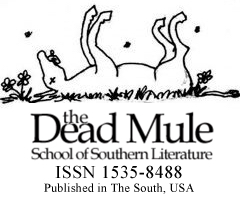Southern Legitimacy Statement: I grew up kicking the 2 inches of pink dust that is formed when the characteristic red clay of the Carolina Piedmont is subjected to a long summer’s baking. Until I was eighteen, I lived in the old farmhouse that Grandpa built in 1910 when he brought Grandma back “home” from Little Rock. At the urging of his brother, Silas, he spent a few years there “working on the railroad,” just long enough to earn enough to buy a farm back in North Carolina. I’ve ridden with my grandpa to “town” in the “Hoover Cart” taking sacks of corn to the mill. I’ve ridden in that same cart to the cotton gin, surveying the world from atop a stack of bales. I went “away” for college, came back, and went away again. (In truth, I learned more from Mamma and my high school English teacher than I did in college or anytime since.) I live in Arizona now. It’s hot there and even further south than where I grew up, but it’s not “Southern” in quite the same way. I like it though. Like some other Southern expats, I feel more Southern “in exile” than I do “at home.”
Tomato Sandwich Fantasies in Mid-November
It’s November, and the first ripe local tomato is at least six months off. Of course, canned tomatoes are available year-round. And tasty cherry tomatoes can be had for much of the year. But I long for the meltingly ripe sandwich-sized tomatoes, where a single slice covers a whole piece of bread. The ur-sandwich-tomato is, of course, the iconic tomato-red fruit. Several fine examples include the giant “Mortgage Lifter” and “Brandywine” strains of beefsteak tomatoes. Both are open-pollinated varieties with, consequently, some variability. “Brandywine” is named after its origin: the Brandywine region of Pennsylvania. The Mortgage Lifter originated in West Virginia. This variety was bred in the 1930s by Marshal Cletis Byles. Byles, who worked as an auto mechanic specializing in auto radiator repair, was widely known as “Radiator Charlie.” The name “Mortgage Lifter” comes from the breeder’s declaration that he sold so many tomato plants that he could pay off the mortgage on his house. Tomato cognoscenti sometimes insist upon honoring this variety with its full name: “Radiator Charlie’s Mortgage Lifter.”
But there are also rich yellow and even green heirlooms that can be equally succulent and delicious and make excellent sandwiches. Superior alternatively-hued fruits include Green Giant, Black Prince, Cherokee Purple, and the Kentucky-bred Pineapple Tomato that sports yellow and red stripes and tastes not at all of pineapple but intensely of tomato. To find any of these heirlooms in a local market is supreme good fortune for a tomato sandwich lover.
Naturally, the first ripe tomato sandwich of the year is a special joy. I claim that day as my own unique and personal favorite annual holiday. It is a movable feast due to the vagaries of the year’s weather and the timing and skill of canny farmers’ intricate preparations to bring the eagerly awaited fruits to market as early as possible. That first sandwich of the season will almost certainly feature the aptly named “Early Girl” tomatoes. That day is always an occasion of mouthfuls of delight. “Do you want another one?” The answer is always, “Yes, please.”
The tomato is a glorious gift from the soils and peoples of the New World. The name even comes from the Nahuatl language of the Aztecs: “tomatl.” It passed into Spanish as “tomate,” spread throughout Europe, and entered English as “tomato.” Notably, the word’s pronunciation distinguishes the British Received Pronunciation from typical American English. Of course, Ira Gershwin’s lyrics to brother George’s music for the 1937 film “Shall We Dance?” play with the sociology of pronunciation when they declare, “You say toe-may-toe, I say toe-mah-toe….“
I am not alone in my enthusiasm and high esteem for the fruit that Italian cuisine dignifies as “pomodoro” or golden apple. The late and justly lamented Anthony Bourdain once fantasized about a retirement in which he saw himself as an elder kneeling devotedly over belovèd tomato plants in Sardinia. Joseph Delteil, in his 1923 novel, Choléra, based on the loves and lusts of a young man and his three paramours during the mid-nineteenth century serial epidemics in Barcelona––sadly apt today––describes a meeting with a man who is unmatched in his devotion to this vegetable that is also a fruit. He is rhapsodic as he apostrophizes it. He addresses the tomato (in French, naturally, perhaps inevitably) as the “joy of the world and rapture of the digestive system.” In the tomato, he finds women’s breasts, solar systems, and the brains of the earth (and I admit to not having a clue as to what that might mean!). His language of ecstatic adoration is worthy of the Loretto Litany.
I first encountered this panegyric through a fragment inscribed on a decorative plate. The plate hung on the wall of a bed-and-breakfast on one of the barrier islands near Charleston, South Carolina. We spent summers on the beach there, eating many tomato sandwiches. I was fascinated by the words. A long search finally revealed its source as Delteil’s erotic novel. (Incidentally, the tetchy André Breton, surrealism’s self-ordained high priest, first embraced and later rejected Delteil as a surrealist. This is the same André Breton who once proclaimed, “The man who cannot visualize a horse galloping on a tomato is an idiot.”)
There are many ways to eat tomatoes, but they find their apotheosis in the tomato sandwich. Although any tomato sandwich is better than no tomato sandwich, the truly peerless tomato sandwich arises only through the offices of grace that are only occasionally received and then only by those who approach the task with the appropriate attitude of reverence and dedication. Through years of practice, my wife, Betsy, has identified the elements of this perfection. They include the following requirements.
First, the sandwich demands the proper bread, always white, ideally a fine-grained pain-de-mie that allows the flavor of the tomato to come through. The bread slices should be about a quarter of an inch thick. This is thick enough for structural integrity but not so much as to make the sandwich overly bready. Then, there must be a light smear of unsalted butter on the inside of the bread to keep it from becoming soggy too quickly. The butter is followed by a generous layer of mayonnaise. (Among devotés, the choice of mayonnaise has caused as much discord and acrimony as the interpolation of the Filioque clause into the Nicene Creed. Indeed, “back home” in the Carolinas, my preference for Hellman’s mayonnaise over the local idol, Duke’s, is considered a heresy deserving the sanction of an anathema.) Finally, the tomato slices should be about twice the thickness of the bread. It is understood that the tomato itself should be large, ripe, and juicy. A sprinkle of fleur-de-sel and a generous dusting of freshly ground black pepper (More! A little more!) completes the delicacy.
These are the sine qua non of a perfect sandwich. As an elective, the sandwich won’t be compromised by some oak leaf lettuce or even a basil leaf or two, but the addition of sliced cheese, although sometimes seen, is an unspeakable faux pas. Bacon transforms the sandwich into a BLT, but that is an entirely different creature and beyond my scope.
One hardly dares even to dream of real summer tomatoes in November, so that perfect sandwich must remain a virtual one for months to come, but with that first bite, real summer will begin, whatever the date. The innocent sweetness of buttered bread will make the perfect foil for the tomato’s darker, more sophisticated complexities, its own ripe sweetness refreshed by bright acidity and enriched by the mysterious and highly sought lusciousness known as umami, the fifth taste. Mayonnaise, always a diplomat, gently pulls the parts together into a delicious unity.
Eyes close in bliss. Salivary glands kick into high gear, and a supernal chorus, gustatory and hormonal, crescendos in four-part harmony: endorphins, serotonin, dopamine, and oxytocin!







